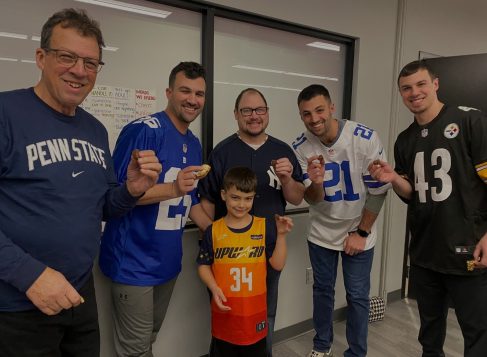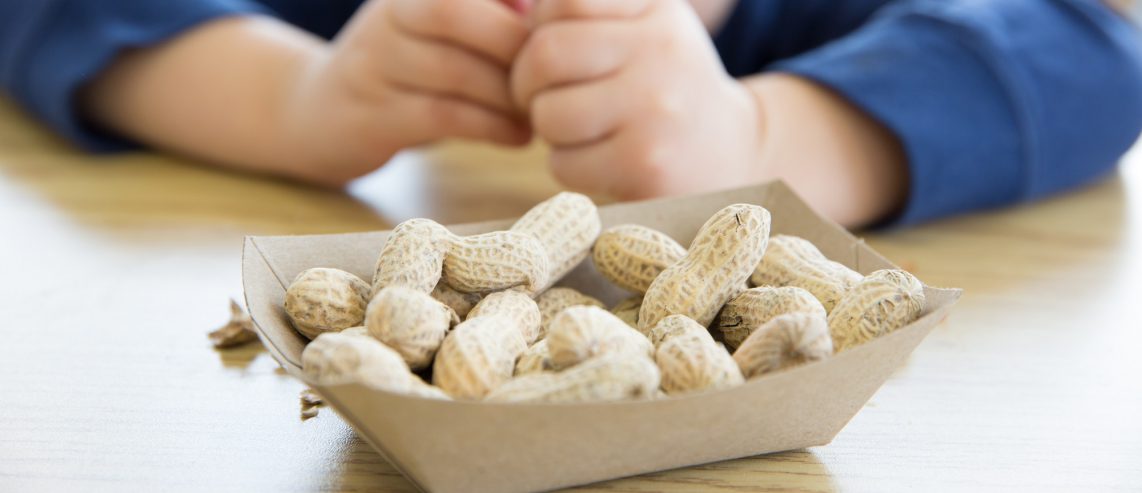One in every 50 children in the United States — and one in every 200 adults — has a peanut allergy. It can have wide-ranging and sometimes dire effects. Symptoms can range from discomfort, like hives and coughing, to anaphylaxis, which is a sudden-onset life-threatening allergic reaction.
Sara Snyder’s son Deacon was just 18 months old when he had an allergic reaction to peanuts.
“I made Deacon a snack with peanut butter on it,” says Sara, of Milton, Pa. “His face became red, and his eyes started swelling shut.”
Sara rushed Deacon to the Emergency Department, where they gave him two shots of epinephrine. The drug, also called adrenaline, works by relaxing muscles in the airways and tightening blood vessels. It is a common emergency treatment for severe allergic reactions.
Afterward, Sara and Deacon were referred to Nathaniel Hare, MD, a UPMC allergy and immunology specialist in Williamsport.
“We haven’t reached the point in medicine with food allergies where there’s a cure,” Dr. Hare says. “But for some food allergies, like a peanut allergy, we may be able to desensitize the patient so they can tolerate ingestion of more of the allergenic food than they would eat with an accidental exposure.”
Deacon’s first appointment with Dr. Hare happened when he was 2 years old. Dr. Hare gave Deacon an allergy skin test plus lab work to confirm the allergy and set a baseline.
Dr. Hare gave the family two options. The first was peanut avoidance — staying away from any food that contains peanuts or peanut oil, or that came from a facility that uses either. The other option was oral immunotherapy (OIT) to build up an immunity to peanuts over time.
Never Miss a Beat!
Subscribe to Our HealthBeat Newsletter!
Thank you for subscribing!
You can now select the specific newsletters you'd like to receive.
You are already subscribed.
Subscribe to more newsletters in our email preference center.
Sorry, an error occurred. Please try again later.
Get Healthy Tips Sent to Your Phone!
The Path to OIT
Sara and her husband Ryan decided to try to avoid peanuts in the hopes that Deacon would outgrow the allergy.
“We had to be constantly vigilant,” Sara says. “We found we could manage it at home, but at school and family gatherings, it was nearly impossible to make sure foods were peanut-free.”
Then Ryan went to Parents’ Day at the end of Deacon’s kindergarten year. He was heartbroken to see his 6-year-old son sitting alone at the peanut-free table. From a safety standpoint, isolation made sense, “but watching Deacon sit apart from his classmates made us reconsider OIT,” says Sara.
 OIT is a process of desensitizing a person to a food to decrease the potential risk for life-threatening allergic reactions. It also aims to reduce reaction anxiety and improve quality of life.
OIT is a process of desensitizing a person to a food to decrease the potential risk for life-threatening allergic reactions. It also aims to reduce reaction anxiety and improve quality of life.
“OIT isn’t a cure, but it can be life-changing,” Dr. Hare says. “The end goal is to get a patient’s immune system to the point that they can eat what they’re allergic to regularly and without any problems. It works for about 80% of people.”
After an initial appointment and lab work, the OIT process begins with the allergic person eating a very small dose of peanut powder in water in increasing increments under supervision in the doctor’s office. They’ll eat that same “go-home-dose” every day for the next week at home.
“The patient sprinkles the peanut powder on food and eats it to make sure it interacts with the immune cells inside their mouth,” Dr. Hare says.
The dose slowly increases weekly in the doctor’s office, and patients eat the new go-home dose every day that week. When safe to do so, patients then switch to eating peanuts in slowly increasing amounts under medical supervision.
At the three-peanut dose, the patient may no longer have to check food labels. After reaching this benchmark, maintenance dosing begins. Maintenance dosing ranges from anywhere between three to eight peanuts, depending on the protocol for the patient. If they stop maintenance dosing, they will likely go back to being allergic.
Patience Pays Off
“Once Deacon reached the three-peanut dose, we were so relieved,” Sara says. “And now he can eat and be around foods with peanuts and finally enjoy lunch with his class!”
Deacon started OIT in mid-July 2022, and his last scheduled appointment at Dr. Hare’s office was in mid-December.
While desensitization isn’t necessarily a long process, potentially taking six to 12 months, it is detailed and very specific.
“Deacon and his family have been great to work with,” Dr. Hare says. “They are invested in Deacon’s care and closely followed the protocol. It’s been great to see him succeed.”
Deacon is now 7 years old. When he graduated from OIT, Sara and Ryan had a “peanut party” with the whole family, including grandparents, aunts, uncles, and cousins. The celebration included some peanut foods.
If you or your child has a food or other allergy, UPMC and UPMC Children’s Hospital of Pittsburgh can help. We provide complete care, from diagnosis to treatment. To find a UPMC allergy provider near you, visit our website. Or, to seek care at UPMC Children’s, visit our website.
Editor's Note: This article was originally published on , and was last reviewed on .
About UPMC
Headquartered in Pittsburgh, UPMC is a world-renowned health care provider and insurer. We operate 40 hospitals and 800 doctors’ offices and outpatient centers, with locations throughout Pennsylvania, Maryland, New York, West Virginia, and internationally. We employ 4,900 physicians, and we are leaders in clinical care, groundbreaking research, and treatment breakthroughs. U.S. News & World Report consistently ranks UPMC Presbyterian Shadyside as one of the nation’s best hospitals in many specialties and ranks UPMC Children’s Hospital of Pittsburgh on its Honor Roll of America’s Best Children’s Hospitals. We are dedicated to providing Life Changing Medicine to our communities.
